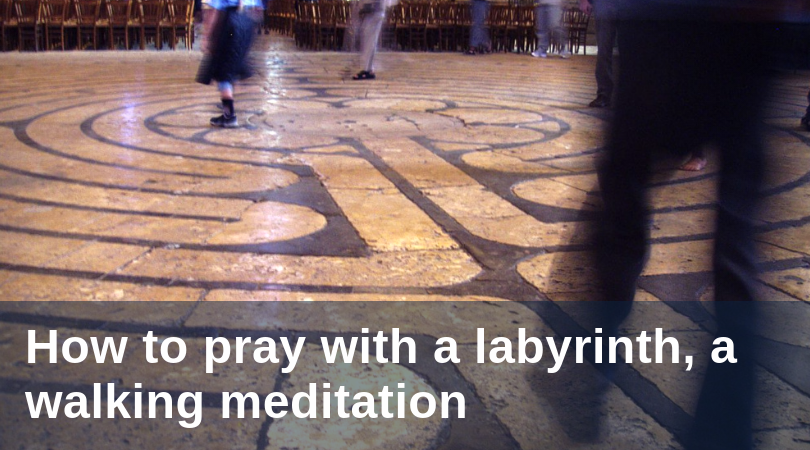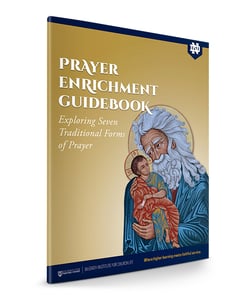
Praying with a labyrinth is a form of walking meditation, a physical expression of the interior journey towards Christ that characterizes all Christian meditation. Like a pilgrimage, forms of walking meditation evoke our earthly journey towards heaven while simultaneously giving us time and space to listen and respond to the Lord.
The origins of the prayer labyrinth
The earliest examples of labyrinths go back nearly 5,000 years, but the use of labyrinths in Christian prayer emerged during the Middle Ages. The most famous example of a Christian labyrinth intended for prayer is the stone labyrinth inlaid on the floor of the Chartres Cathedral in France. However, you can find prayer labyrinths in most areas of the country, from abbeys and monasteries to the campuses of Catholic parishes and colleges.
“Meditation is above all a quest. The mind seeks to understand the why and how of the Christian life, in order to hear and respond to what the Lord is asking.” - Catechism of the Catholic Church, 2705
Why you might pray with a labyrinth
Where we pray affects how we pray. Most of the time, we seek to pray in places of quiet and stillness. At other times, taking a walk or simply being outside helps us pray. Although we can embark on a walking meditation nearly anywhere, the predictable and concentrated route of a labyrinth frees us from the inevitable distractions that come with being out on a walk (like recalling directions or wondering when to turn back). If being outdoors makes you feel closer to God or if pilgrimage has been influential in your spiritual life, then praying with a labyrinth might be a helpful practice.
How to pray with a labyrinth
Since a prayer labyrinth is an external aid to prayer, we can use it to help with forms of prayer that are already familiar to us like the Rosary or the Examen. Of course, we can also use the labyrinth as a walking meditation as described below.
Find a labyrinth
Look for a prayer labyrinth in your area. If you can’t find one nearby, you still have options. You can make a basic one in your backyard (some paving stones will do the trick) or you can use the perimeter of your backyard to similar effect. If you live near a park, you can walk along a predetermined path or trace some other feature of the landscape. The key is finding a place where you will be relatively undisturbed either by other people or the need to make decisions about the direction you are heading.
Scriptural preparation
Consider reading a passage from Scripture to set your mind on God’s accompaniment with you during this short pilgrimage of prayer. There are many possibilities, but here are a few to get you started: Deuteronomy 1:31, Exodus 13:21-22, Isaiah 42:1-9, Luke 24:13-35.
Steps of praying with a Labyrinth
Once you have found a labyrinth or other suitable place to pray, you can begin your walking meditation with the following steps.
- Name your intention
Since we embark on a walking meditation in order to hear and respond to the Lord, invite God to walk with you during this prayer period. Ask for the grace to hear and respond to him. If you have any particular intentions on your heart, name them to God at this time and tell him that you will carry these intentions with you during the walk. - Walk the path
Enter and follow the path of the labyrinth, knowing that God is with you. Go at a pace that feels natural. As you move along the path, notice what is happening in your mind and heart. There is no agenda to this prayer. Rather, let your prayer unfold as you go and trust in God’s guidance. If your mind wanders to thoughts that seem like distractions, name the distraction, lift it up to God and ask God to guide your mind and heart back to him. If the distraction returns, explore it with God. - Give thanks
When you reach the center of the labyrinth, thank God for having walked with you along the way. - Reflect
Afterwards, take time to reflect on your walking meditation. Write down your thoughts, feelings or anything else that you experienced. If something from these recollections stands out to you, consider exploring it at another time in prayer or in spiritual direction.
Download the complete Prayer Enrichment Guidebook
 This article is the fourth installment of our seven-week Prayer Enrichment Series which comes directly from our free Prayer Enrichment Guidebook.
This article is the fourth installment of our seven-week Prayer Enrichment Series which comes directly from our free Prayer Enrichment Guidebook.
The Prayer Enrichment Guidebook introduces seven traditional styles of Catholic prayer, including lectio divina, the Examen and centering prayer.
The entry for each prayer practice introduced in this guidebook contains:
- A brief overview of the prayer practice
- Its origins
- Why one might practice it
- How one can practice it
This Prayer Enrichment Guidebook is an aid for all Christians to deepen their relationship with the Lord through new forms of prayer. It is an ideal supplement for Catholic teachers, catechists, ministers and anyone who seeks to encounter God in a new way.



